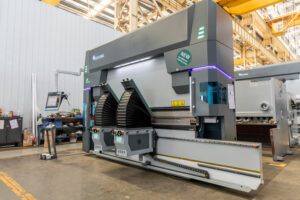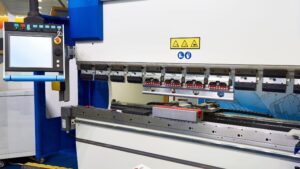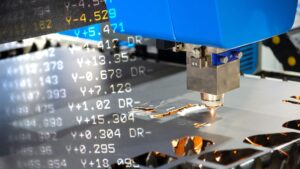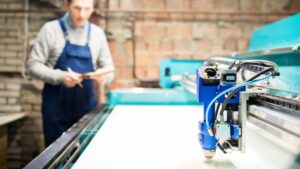What is Laser Cutting and How Does it Work?
Laser cutting is a process where a laser beam is used to cut or engrave materials. The laser, either a carbon dioxide (CO2) or a fiber laser, produces a beam that is directed by mirrors onto the material. The focused beam has a diameter as small as a few microns, comparable to the thickness of a human hair.
Laser cutting accuracy depends on several factors, including the type of laser, the power of the laser, and the material being cut. Cutting tolerances are typically within ±0.005 inches, ensuring high precision in manufacturing applications.
How Accurate is Laser Cutting?

The dimensional accuracy of laser cutting is impressive, usually within ±0.005 inches. The cut width, or laser cutting kerf, can be as narrow as 0.004 inches, depending on the laser power and material thickness.
Laser cutting can focus down to 10-20 microns, showcasing its ability to produce highly intricate and detailed work. This precision is crucial in industries like aerospace, electronics, and automotive, where exacting standards are the norm.
How Does Laser Cutting Compare in Precision to Other Cutting Methods?
Compared to traditional cutting methods like plasma cutters and mechanical cutting tools, laser cutting offers superior precision.
For instance, plasma cutting typically has a tolerance of ±0.020 inches, which is less precise than laser cutting.
Mechanical cutting tools, while versatile, can’t match the intricate detailing possible with laser cutting. The ability to produce complex shapes and designs with high repeatability makes laser cutting a preferred choice for many applications.
Types of Laser Cutters: Which Is the Most Accurate?
Different types of laser cutters offer varying levels of accuracy, each suited to specific materials and applications. The three primary types are fiber laser cutters, CO2 laser cutters, and crystal laser cutters.
Fiber Laser Cutters
Fiber laser cutting technology uses banks of diodes to create a laser that is channeled and amplified through fiber-optic cable. This results in a focused, high-intensity laser beam.
- Dimensional Accuracy: Fiber laser cutters are known for their exceptional precision, often achieving tolerances as tight as ±0.003 inches. The focused beam spot size can be extremely small, allowing for intricate cuts and detailed work.
- Applications: Ideal for cutting metals like stainless steel and aluminum, fiber lasers are widely used in industries where precision is paramount, such as aerospace and automotive manufacturing.
- Advantages: They offer faster cutting speeds and lower operating costs compared to other types. Their ability to precisely cut thin materials is particularly noteworthy.
CO2 Laser Cutters
CO2 laser cutters use a gas mixture, typically involving carbon dioxide, to produce the laser beam. The beam is then directed and focused using mirrors and lenses.
- Dimensional Accuracy: CO2 laser cutters generally provide tolerances around ±0.005 inches. They are highly effective for cutting thicker materials and deliver clean, precise cuts.
- Applications: Commonly used for a wide range of materials, including plastics, wood, and metals. They are a staple in industries like HVAC and signage, where versatility in material cutting is required.
- Advantages: These cutters are known for their versatility and are capable of cutting a wide range of materials with high-quality results.
Crystal Laser Cutters
Crystal laser cutters use crystals like neodymium-doped yttrium aluminum garnet (Nd:YAG) to produce the laser beam. These crystals allow for very high-intensity beams.
- Dimensional Accuracy: The accuracy of crystal laser cutters is comparable to fiber lasers, often achieving tolerances within ±0.004 inches. They are well-suited for cutting both thin and moderately thick materials.
- Applications: Frequently used for tasks requiring high precision, such as in the medical device and electronics industries.
- Advantages: These lasers can handle a variety of materials, including metals, ceramics, and some plastics, with high precision and speed.
What are the Factors That Determine the Precision of Laser Cutting?
In the intricate world of laser cutting, precision is paramount. The accuracy of laser cutters is not a singular attribute but a composite result of several interlinked factors. Understanding these determinants is crucial for any professional in manufacturing applications, from aerospace to electronics, where laser cutting technology plays a pivotal role.
- Laser Type: The choice between CO2, fiber, and crystal lasers significantly influences cutting precision. Fiber lasers, for example, offer tighter focus and hence, higher precision, especially for thin materials.
- Laser Power: Higher-powered lasers can cut thicker materials but might sacrifice precision. Conversely, lower power can enhance accuracy but limit material thickness capabilities.
- Material Thickness: Thicker materials often challenge the laser’s ability to maintain precision, as the beam may spread slightly over greater distances.
- Material Type: Different materials respond uniquely to laser cutting. Metals like stainless steel and aluminum might require different settings compared to plastics or wood.
- Cutting Speed: Faster speeds can reduce cutting time but might compromise accuracy. A balance must be found for optimal precision.
- Machine Quality and Maintenance: High-quality laser cutting machines and regular maintenance ensure consistent precision. Worn components or misalignments can significantly affect accuracy.
- Environmental Factors: Factors like ambient temperature and humidity can affect both the laser cutter and the material, impacting the cutting precision.
- Operator Skill: The experience and expertise of the machine operator play a significant role in achieving high precision in laser cutting.
How Do Cutting Tolerances Influence Laser Cutting Accuracy?
Laser cutting tolerances are critical for achieving high precision in various manufacturing applications. These tolerances refer to the degree of variation permissible in the cutting process.
- Kerf Width: The kerf, or the width of the cut, is typically in the range of 0.004 to 0.012 inches for most lasers. This narrow kerf allows for intricate cuts and minimal material waste.
- Dimensional Tolerance: Dimensional accuracy in laser cutting generally falls within ±0.005 inches, allowing for precise cuts and fitting parts with high accuracy.
- Positioning Tolerance: Positioning tolerance, which refers to the laser’s accuracy in placing cuts, is usually within ±0.002 inches, ensuring that each cut is made exactly where intended.
These tolerances illustrate why laser cutting is favored for its precision, especially in fields requiring intricate details and exact measurements, like electronics and aerospace.
How does Material Choice Impact Laser Cutting Accuracy and Precision?

The selection of material plays a pivotal role in the precision of laser cutting. Each material type, with its unique physical and chemical properties, interacts differently with the laser beam.
Metals
Metals often require higher laser power for cutting but offer excellent precision. Materials like stainless steel and aluminum are commonly used due to their favorable response to laser cutting.
- Stainless Steel: Known for its hardness, stainless steel can maintain a high level of detail when cut with a laser. Typical dimensional accuracies for stainless steel range from ±0.002 inches to ±0.005 inches, making it ideal for intricate designs and industrial applications.
- Aluminum: Although a softer metal, aluminum’s reflectivity requires careful handling during laser cutting. The achievable precision is generally within ±0.003 inches to ±0.006 inches. Aluminum is often used for its lightweight properties in aerospace and automotive parts.
Plastics
Plastics vary widely in their laser cutting capabilities. Some, like acrylic, cut cleanly and precisely, while others may melt or warp, affecting accuracy.
- Acrylic: Acrylic cuts with a smooth, flame-polished edge, and the typical accuracy can be within ±0.004 inches. It’s popular in signage and display manufacturing due to its clarity and precision.
- Polycarbonate: Despite being a versatile plastic, polycarbonate tends to discolor and form burrs when laser cut. Dimensional accuracy is around ±0.005 inches to ±0.010 inches, depending on thickness and laser settings.
Wood
While wood can be laser cut, its variable density can lead to inconsistencies in precision, especially with intricate designs or thin cuts.
- Hardwoods: Hardwoods like oak and maple offer better consistency in laser cutting, with typical accuracies of ±0.005 inches. They are preferred for high-detail work.
- Softwoods: Softwoods, such as pine, may have greater variations due to their lower density. The accuracy might range from ±0.005 inches to ±0.010 inches, influenced by factors like moisture content and grain pattern.
Glass and Ceramics
These materials can be challenging for laser cutting due to their brittleness and risk of cracking, which can compromise precision.
- Glass: Glass requires low power and high speed to prevent cracking, resulting in accuracies around ±0.007 inches. It’s often used in decorative applications.
- Ceramics: Ceramics can achieve precision within ±0.006 inches, but the process demands careful control to avoid fractures, making it suitable for specialized industrial applications.
What are some Common Misconceptions About Laser Cutting Accuracy?
Laser cutting technology, a cornerstone in modern manufacturing applications, is often surrounded by misconceptions that can skew our understanding of its capabilities and limitations. Addressing these misconceptions is vital to leverage laser cutting services effectively.
- “All Laser Cutters Have the Same Accuracy”: Contrary to this belief, the accuracy of laser cutters varies based on the type (CO2, fiber, or crystal), power settings, and design. Each type has its unique advantages and limitations that influence precision.
- “Laser Cutting is Always the Most Precise Method”: While laser cutting is incredibly precise, its accuracy can be influenced by factors like material type, thickness, and machine maintenance. In some cases, other methods like CNC machining might be more suitable.
- “Thicker Materials Can Be Cut with the Same Precision as Thinner Ones”: The truth is, cutting thicker materials often challenges the laser’s precision due to beam spread and heat dispersion.
- “Laser Cutting is Only for Metal Cutting”: Laser cutting technology extends beyond metals. It’s effectively used for plastics, wood, and even glass, although each material requires specific settings for optimal accuracy.
What are Design Considerations for Optimal Laser Cutting Accuracy?

Achieving optimal accuracy in laser cutting is not just about the technology but also involves careful planning and design considerations. Here are some essential design tips and considerations for enhancing laser cutting accuracy:
- Material Selection: Choose the right material for your project. Consider how different materials like metals, plastics, and wood react to laser cutting.
- Understanding Laser Capabilities: Be aware of the limitations and strengths of the laser cutter being used. Adjust your design accordingly.
- Minimizing Heat Impact: Design your project to minimize the effects of heat, such as warping, which can affect accuracy.
- Cut Order Control: Plan the order of cuts to reduce the risk of material movement or changes during the cutting process.
- Creating Guides: Use guides in your design files to ensure precise cuts. This is especially important for intricate designs or when repetitive accuracy is required.
- Optimal Settings Selection: Choose the right laser power, speed, and frequency settings based on the material and thickness.
- Regular Maintenance: Ensure the laser cutter is well-maintained. Regular calibration and alignment can significantly impact accuracy.
- Skilled Operation: The operator’s skill is crucial. Experienced operators can adjust settings and procedures to optimize accuracy.
What are Important Preparations to Enhance Laser Cutting Precision?
Laser cutting, a process integral to industries from aerospace to HVAC, requires meticulous preparation to achieve the highest level of precision. Effective preparation not only enhances accuracy but also maximizes the efficiency of laser cutting machines. Here are key preparations and specifications to consider:
- Material Quality and Flatness: Ensure the material is of high quality and perfectly flat. Irregularities can affect the laser’s focus and precision.
- Proper Material Support: Use appropriate feeding systems or supports to prevent material movement during the cutting process.
- Optimal Laser Settings: Adjust laser power, speed, and frequency based on material type and thickness for precise cuts.
- Regular Maintenance of Laser Machines: Keep the laser cutter well-maintained, including regular checks on the laser head, mirrors, and lens for alignment and cleanliness.
- Accurate CAD Software Design: Ensure design files are accurate and optimized for laser cutting, considering aspects like kerf adjustment and material properties.
For specific features in designs, certain considerations are crucial:
- Holes: The diameter of holes should not be smaller than the material thickness to maintain structural integrity and precision.
- Slots: Similar to holes, the width of slots should be at least as wide as the material thickness.
- Size and Unsupported Areas: Manage the size and positioning of unsupported areas to prevent material distortion or dropping during the cutting process.
What are Safety Measures for Precise and Secure Metal Laser Cutting?
Safety in laser cutting is paramount, not only for the protection of operators but also for maintaining the precision of the cutting process. Here are essential safety tips for metal laser cutting:
- Proper Training and Supervision: Ensure that machine operators are well-trained and understand the intricacies of the laser cutting machine and process.
- Use of Protective Gear: Operators should wear appropriate safety gear, including eye protection and heat-resistant gloves.
- Regular Inspection of Safety Features: Regularly check the laser cutter’s safety features, like emergency stops and guards, to ensure they are functioning correctly.
- Maintain a Clean and Organized Workspace: A cluttered workspace can lead to accidents. Keeping the area clean and organized minimizes risks.
- Proper Ventilation: As laser cutting can produce fumes and smoke, especially when cutting metals, adequate ventilation is crucial to maintain a safe working environment.
- Avoid Direct Laser Beam Exposure: Ensure that the laser beam is never directed towards people or reflective surfaces to prevent accidents.
- Emergency Procedures: Have clear emergency procedures in place and ensure all operators are familiar with them.
The Role of Maintenance in Laser Cutting Precision

In the precise world of laser cutting, regular and thorough maintenance is a cornerstone for ensuring optimal performance and accuracy. Maintenance is not just about preventing machine breakdowns; it’s about sustaining the high precision that laser cutting machines, such as fiber lasers and CO2 lasers, are known for. Here’s how maintenance impacts laser cutting precision:
- Alignment Checks: Regular alignment checks of the laser beam are crucial. Misalignment, even by a fraction, can lead to significant deviations in cut quality and accuracy.
- Lens and Mirror Cleaning: Dust or residue on lenses and mirrors can distort the laser beam, affecting the precision of cuts. Clean optics ensure the laser path remains unobstructed and accurate.
- Regular Calibration: Calibration of the laser cutting machine ensures that the cutting parameters remain true to the design files, maintaining accuracy in dimensions and cut quality.
- Checking and Adjusting Laser Power: The power of the laser needs regular monitoring and adjusting to match the cutting requirements accurately. Inconsistent power levels can lead to uneven cuts.
- Wear and Tear Monitoring: Components like the laser head, belts, and bearings undergo wear and tear. Keeping these parts in good condition is essential for maintaining cutting precision.
Maintaining these aspects ensures that the laser cutter operates at its optimal precision, essential for industries that rely on the exactness of laser-cut parts.
Ranking the Top Metal Laser Cutting Machines for Precision
In the competitive market of metal laser cutting machines, precision is a key differentiator. To assess the quality and performance of these machines, several criteria need to be considered. Here’s what to look for when ranking laser cutting machines for precision:
- Cutting Speed and Acceleration: Machines with higher cutting speeds and acceleration, like the ACCURL fiber laser cutting machines, which boast a positioning speed of up to 180m/min and an acceleration of 3G, are indicators of advanced technology and precision.
- Laser Power Range: The power range, especially in high-end machines that offer up to 30kW (like certain models from ACCURL), dictates the machine’s ability to cut through various materials and thicknesses precisely.
- System Stability: The stability of the laser cutting system during operation, which impacts the consistency and accuracy of cuts.
- Control Software Compatibility: Software that accurately translates CAD designs into precise cuts is essential. The software’s ability to handle complex designs and intricate cuts matters significantly.
- User Reviews and Industry Reputation: Feedback from users and the machine’s standing in the industry provide real-world insights into its precision and reliability.
Machines like the ACCURL fiber laser cutters, known for their high dynamics, top quality, and advanced technology, often rank high in these criteria, making them a preferred choice for precision laser cutting.
Conclusion
Achieving precision in laser cutting is an interplay of several factors – from the meticulous maintenance of the equipment to the choice of cutting machines like ACCURL fiber lasers known for their high-speed capabilities and precision.
As the industry evolves, the future of laser cutting looks towards even more refined technologies, with advancements in laser power, cutting speeds, and software integration. This progression will further enhance the precision of laser cutting, catering to the increasingly intricate and demanding designs of modern manufacturing applications.







